Want to add a moss pole for plants in your home? Here are the best Houseplants for Moss Poles that you might partner it with!
I love collecting a variety of houseplants for my indoor jungle. An, a lot of popular indoor plants are trailing or climbing naturally.
While it’s fun to drape their branches across a shelf, it can also be great to give a plant something to climb.
Moss poles are a great plant support option. These poles are typically made from sphagnum moss or coconut fibers and allow for aerial roots to grow into the soft, natural material.
Whether you are a beginner houseplant owner with your first plant or just have a few moss pole segments left over, let’s dive into the best plants to grow on moss poles!
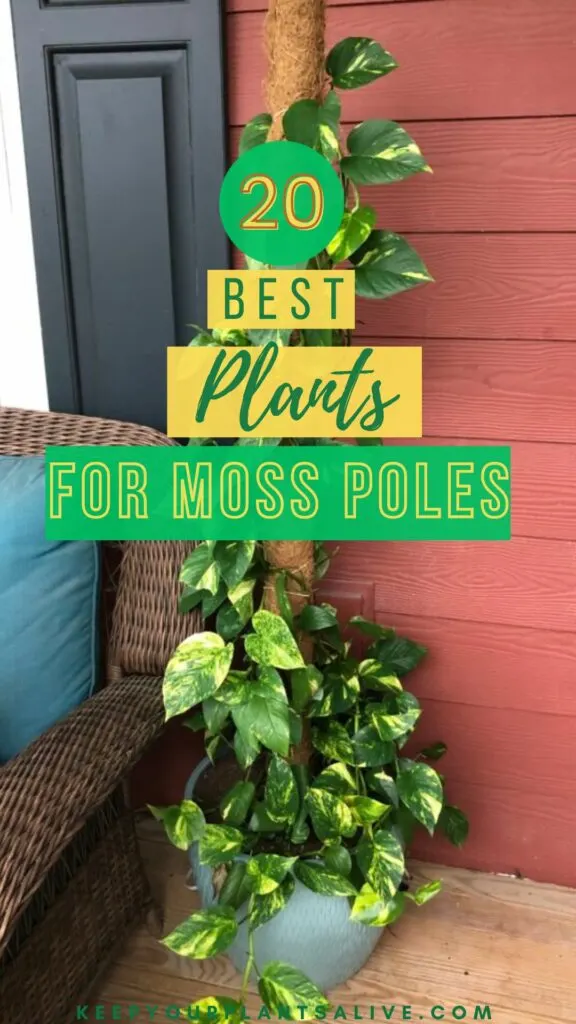
Understanding Moss Poles
Moss poles are vertical poles wrapped in a soft natural material that climbing plants can grow into and grow up.
Common types of moss poles include a sphagnum moss pole or a coco coir pole.
Benefits of using a moss pole
Some of the benefits from a moss pole include:
- Structural Support: Moss poles provide essential support for climbing and trailing plants, helping them maintain an upright and well-organized growth habit. This prevents the plants from sprawling or flopping over, ensuring they grow in a more compact and visually appealing manner.
- Vertical Growth Promotion: Moss poles encourage vertical growth in plants that naturally climb or trail. By providing a sturdy structure for the plants to cling onto, moss poles enable them to reach upward and create a captivating display of foliage and vines. This vertical growth adds height and dimension to indoor spaces, making them more visually interesting.
- Space Optimization: Using moss poles allows you to maximize the use of vertical space in your home. By training plants to climb or trail along the moss poles, you can create a lush and vibrant green display without occupying valuable floor space. This is particularly beneficial for smaller living areas or when you want to add greenery in areas with limited room.
- Aesthetics: Moss poles can significantly enhance the aesthetic appeal of your indoor jungle. The presence of climbing or trailing plants on moss poles adds a touch of elegance and natural beauty to any space, transforming it into a lush, green sanctuary. The vertical growth and cascading foliage create a visually dynamic and captivating atmosphere.
- Plant Health and Well-being: For certain plants, moss poles provide an environment that mimics their natural habitat. They offer stability for aerial roots, encourage air circulation, and can help prevent issues like rotting or waterlogging. Moss poles also give plants access to additional light as they climb closer to windows or other light sources, promoting healthier growth.
- Easy Maintenance: Moss poles are relatively low-maintenance. They can be easily incorporated into your regular plant care routine, requiring minimal effort. Pruning and training the plants on the moss poles can help maintain their desired shape and prevent overcrowding.
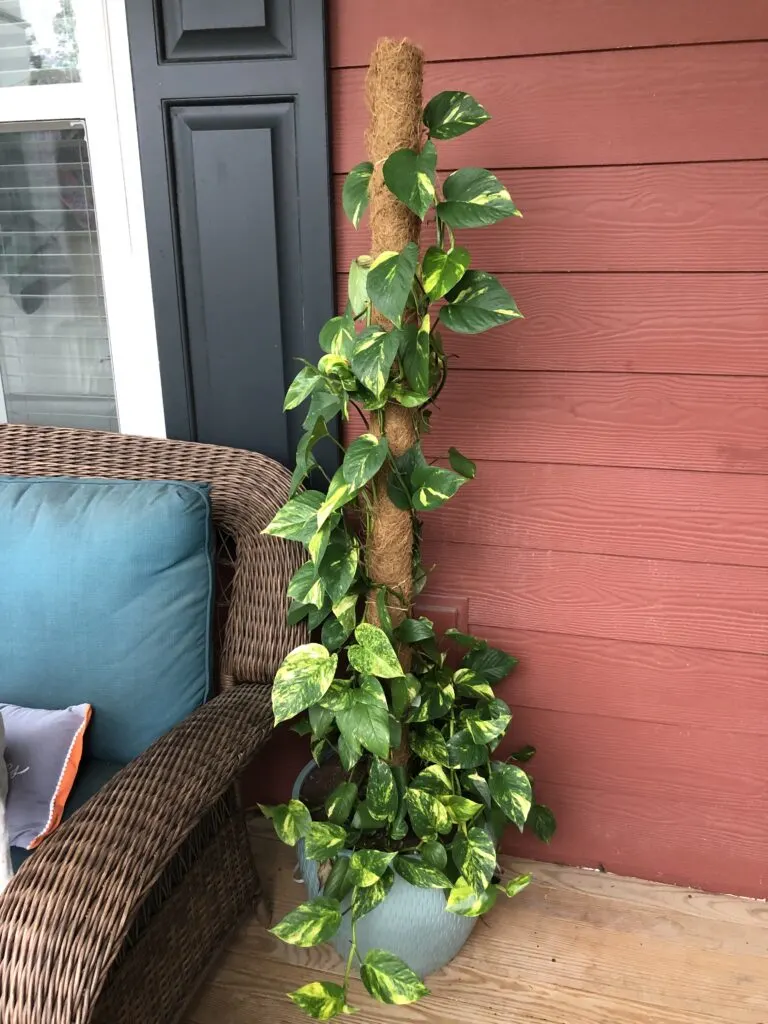
How to make a moss pole
You can purchase moss poles but you can also easily make them with moss or coco coir, a pole of some sort, and either wire or rope to hold it al together.
Click here to see my full tutorial on how I made my moss pole!
How to attach plants to moss poles
Ideally, vining plants will wind around the moss pole and naturally hold themselves in place. However, at first they might need a little support in the form of ties. You can read my method for attaching new plants to moss poles here!
Moss pole alternatives
If you don’t want a moss pole for some reason, you can get a similar effect from:
- Trellis: A trellis is a popular alternative to moss poles and can provide sturdy support for climbing plants. It typically consists of a framework made of wood, metal, or other materials, with crisscrossed slats or wires that plants can latch onto as they grow.
- Wall-mounted hooks or brackets: These can be used to support vining plants by providing an anchor point for their growth. You can attach hooks or brackets to the wall and train the plant’s vines to climb and weave along them.
- Plant poles or stakes: Similar to moss poles, you can use plant poles or stakes made of materials like bamboo, wood, or metal. These can be inserted into the potting soil alongside the plant, providing support for its growth.
- Plant ladders: Plant ladders consist of multiple horizontal slats or steps, providing a tiered structure for climbing plants to grow along. This alternative is particularly useful if you have multiple plants that need support within a limited space.
- Macrame hangers: Macrame hangers are a decorative and trendy way to support trailing plants. These hangers are made of ropes or cords that suspend the plant’s pot from the ceiling or a hook, allowing the trailing vines to cascade down naturally.
- Decorative stakes or hoops: For smaller plants or those with more delicate climbing habits, decorative stakes or hoops can be used. These come in various shapes and designs, adding aesthetic appeal while providing minimal support for the plant.
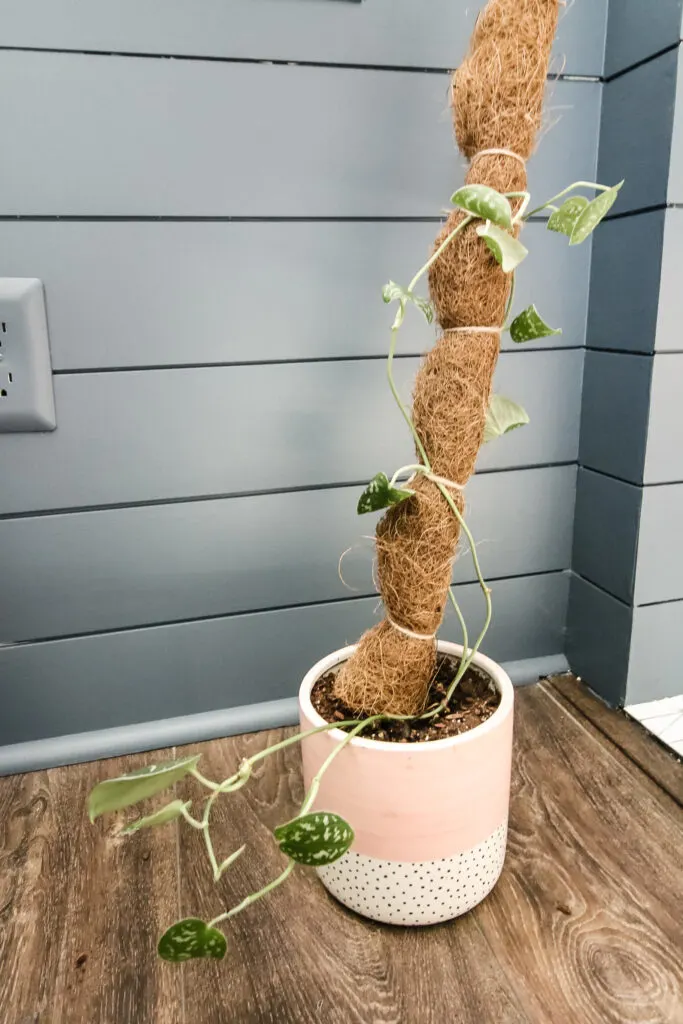
Criteria for Selecting Plants for Moss Poles
When deciding if a plant is suited for a moss pole, consider their typical growth patterns and natural climbing preferences.
Consider the growth habit and size of the plants
Opt for plants with a natural climbing or trailing growth habit that can utilize the moss pole effectively.
Take into account the mature size of the plant to ensure it will have enough space to grow and thrive on the moss pole without becoming overcrowded.
Focus on plant species that possess natural tendencies to cling, climb, or produce aerial roots, as these are ideal candidates for moss poles. These plants can naturally latch onto the moss pole for support.
Examples include:
- Philodendrons
- Monsteras
- Pothos
- Hoyas
Consider factors such as light requirements, humidity preferences, and temperature tolerances of the plant species.
Ensure that the plant selected for the moss pole is compatible with the environmental conditions in which the moss pole will be placed.
By considering the growth habit and size of the plants, favoring species with natural climbing tendencies, and ensuring compatibility between the plant’s needs and the moss pole environment, beginners can choose suitable plants that will thrive and beautify their moss pole displays.
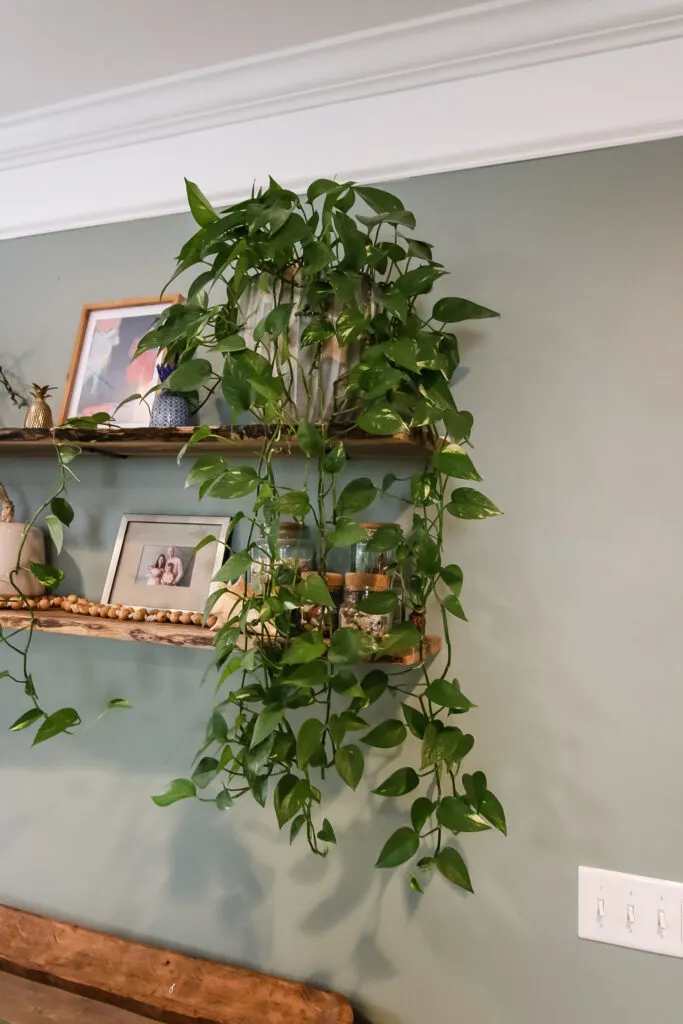
Additional Tips for Moss Pole Success
Here are a few more tips to ensure success when using a moss pole with your plants.
Importance of Proper Placement and Support for Moss Pole Plants
Moss poles can be crucial in providing structural support and promoting vertical growth.
Ideally, place the pole centrally in the pot to ensure adequate light, airflow, and accessibility for watering and maintenance.
Choosing an appropriate-sized moss pole to accommodate the plant’s growth potential is also important. This is why I love moss poles that you can add segments on to as needed!
Watering and Fertilization Considerations for Moss Pole Plants
It is important to determine the plant’s specific watering needs based on its species and environmental conditions. Most plants that do well with moss poles require consistent moisture without overwatering or allowing the moss pole to dry out.
You might want to consider misting your pole to keep it slightly damp and encourage the roots to grow into the coco coir or other moss coating.
Fertilization can really help to increase your plant’s growth and get it climbing the moss pole faster. and The use of balanced, water-soluble fertilizers can be key to promote healthy growth.
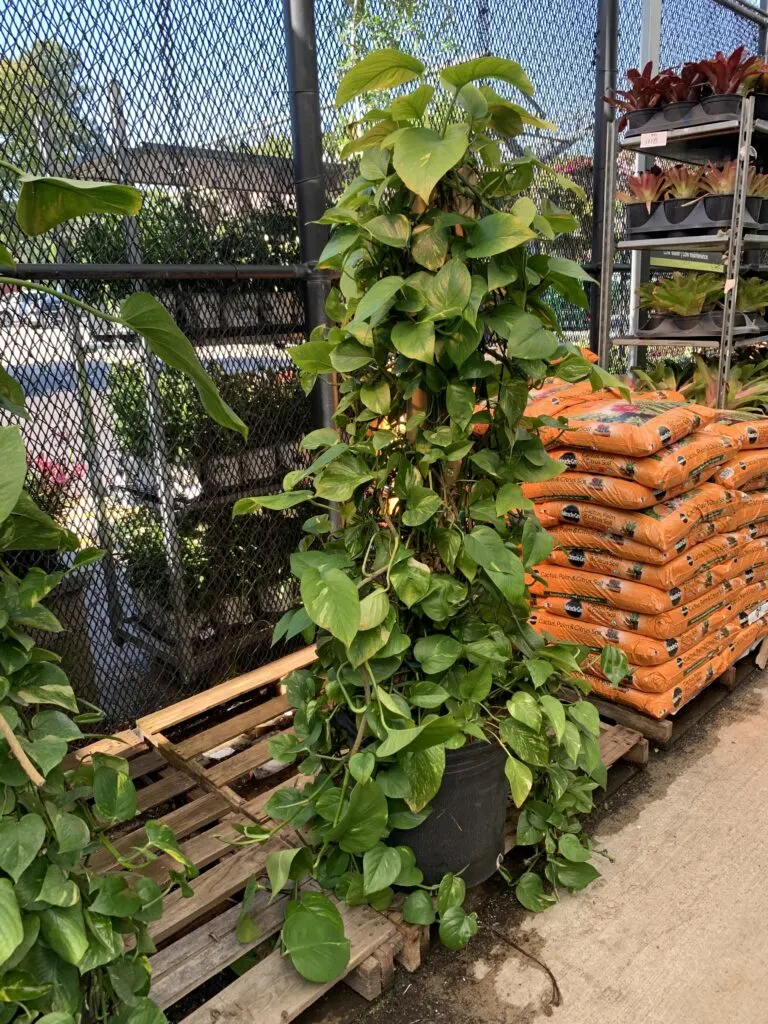
Top Houseplants for Moss Poles
Here are the plants that do best with a moss pole!
Philodendron (Philodendron hederaceum)
Climbing Varieties: Philodendron Brasil, Philodendron Heartleaf
Philodendron (Philodendron hederaceum), also known as Heartleaf Philodendron, is a popular and versatile houseplant with heart-shaped, glossy green leaves that trail elegantly.
Its easy-care nature and ability to thrive in a variety of light conditions make it an ideal choice for beginners and a perfect candidate for training on a moss pole to enhance its climbing tendencies.
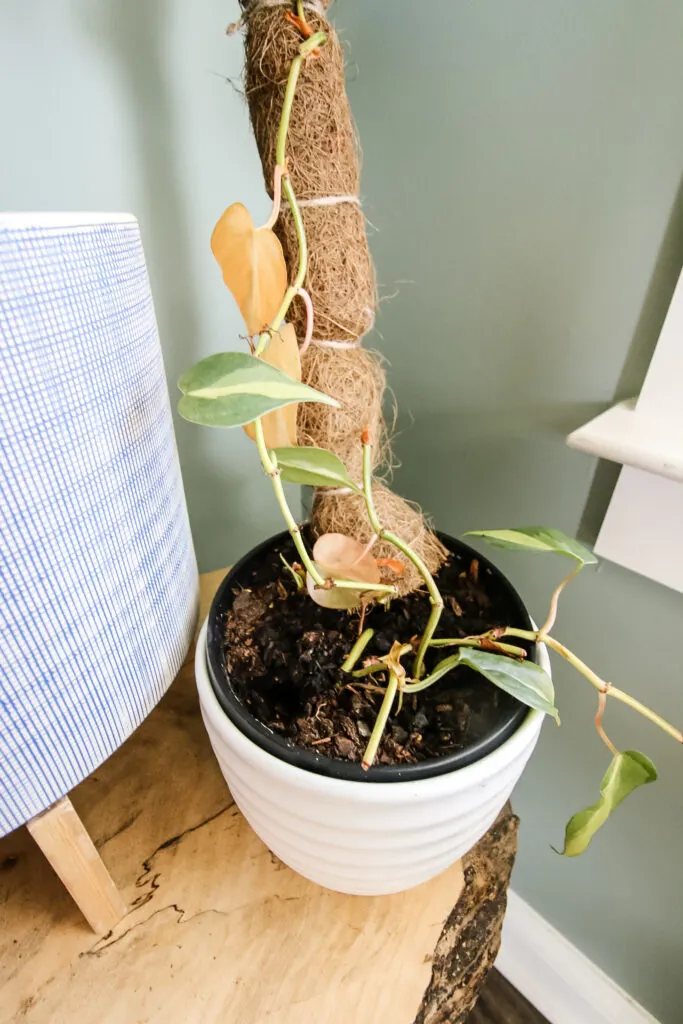
Monstera deliciosa
Climbing Varieties: Monstera Adansonii, Monstera Siltepecana
Monstera deliciosa, commonly known as the Swiss Cheese Plant, is a striking houseplant admired for its large, fenestrated leaves that develop unique perforations as it matures.
With its iconic tropical aesthetic and vigorous climbing growth, Monstera deliciosa is a captivating addition to any indoor space, especially when supported by a moss pole to encourage its natural climbing behavior.
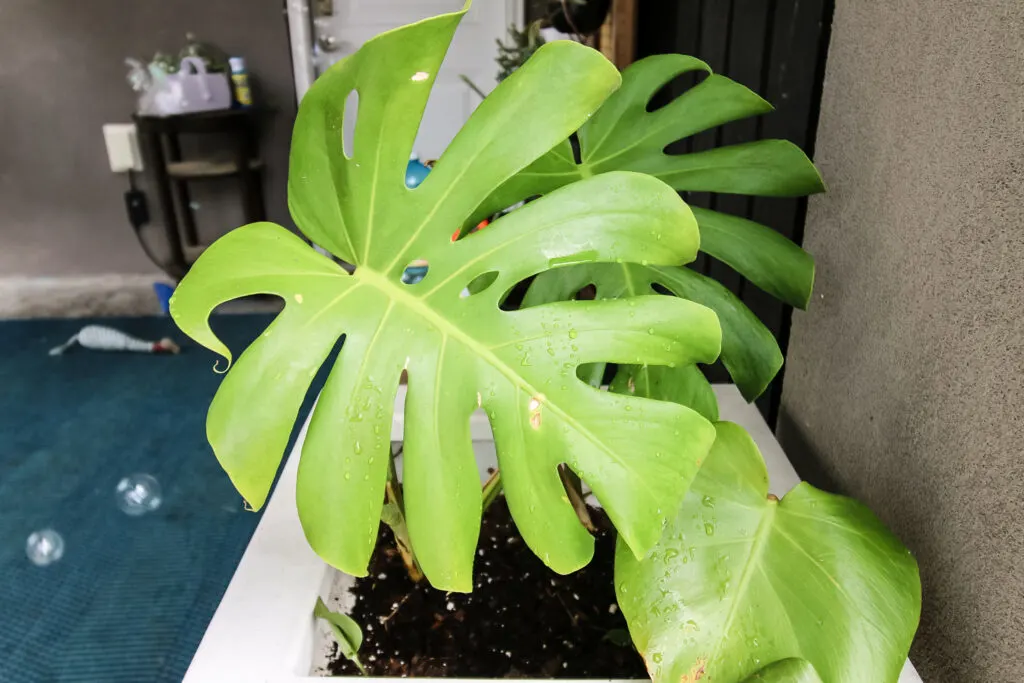
Syngonium (Syngonium podophyllum)
Climbing Varieties: Syngonium White Butterfly, Syngonium Neon Robusta
Syngonium (Syngonium podophyllum), also referred to as Arrowhead Plant or Goosefoot Plant, is a versatile and visually appealing houseplant known for its arrowhead-shaped leaves that display a captivating range of colors, including variegated patterns of green, white, and pink.
With its trailing or climbing growth habit, Syngonium thrives on a moss pole, providing an excellent opportunity for beginner houseplant owners to enhance their indoor jungle and showcase its lush foliage.
Hoya bella (Miniature Wax Plant)
Climbing Varieties: Hoya bella ‘Variegata,’ Hoya bella ‘Compacta’
Hoya bella, commonly known as the Miniature Wax Plant, is a charming and compact houseplant that features small, waxy, and beautifully shaped leaves.
Its delicate vines and clusters of star-shaped flowers make Hoya bella an enchanting addition to any space, and its suitability for moss poles allows it to gracefully climb and display its unique foliage.
Scindapsus pictus (Satin Pothos)
Climbing Varieties: Scindapsus Treubii, Scindapsus Silver Satin
Scindapsus pictus, also known as Satin Pothos or Silver Philodendron, is a stunning houseplant recognized for its heart-shaped leaves adorned with silver variegation that shimmers in the light.
With its trailing vines and cascading growth, Scindapsus pictus thrives when trained on a moss pole, offering a captivating display of lush foliage that adds a touch of elegance to any indoor jungle.
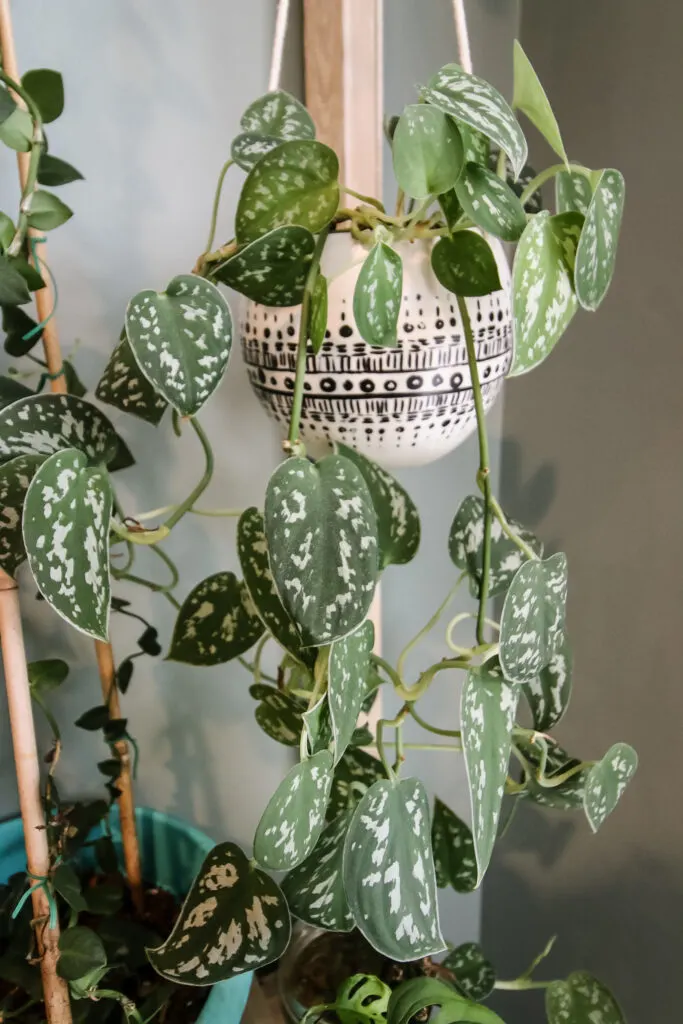
Epipremnum pinnatum (Dragon Tail Plant)
Climbing Varieties: Epipremnum pinnatum ‘Cebu Blue,’ Epipremnum pinnatum ‘N’Joy’
Epipremnum pinnatum, commonly known as the Dragon Tail Plant, is a striking houseplant featuring elongated, deeply lobed leaves that resemble the tail of a dragon.
With its unique foliage and climbing nature, Epipremnum pinnatum is an eye-catching choice for moss pole enthusiasts, as it gracefully wraps and climbs, creating a visually dynamic and captivating display in any space.
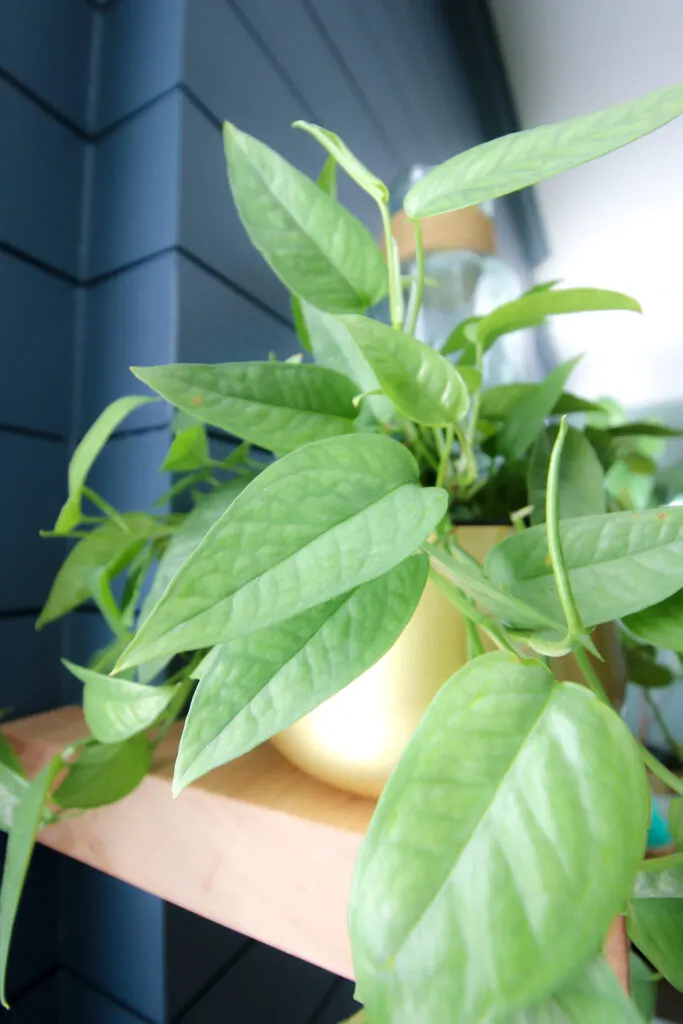
Epipremnum aureum ‘N’Joy’ (N’Joy Pothos)
Climbing Varieties: Epipremnum aureum ‘Marble Queen,’ Epipremnum aureum ‘Neon’
Epipremnum aureum ‘N’Joy,’ commonly known as N’Joy Pothos, is a delightful houseplant with heart-shaped leaves featuring green and white variegation.
Its climbing varieties, such as Epipremnum aureum ‘Marble Queen’ and Epipremnum aureum ‘Neon,’ offer a stunning range of patterns and colors for your moss pole arrangement.
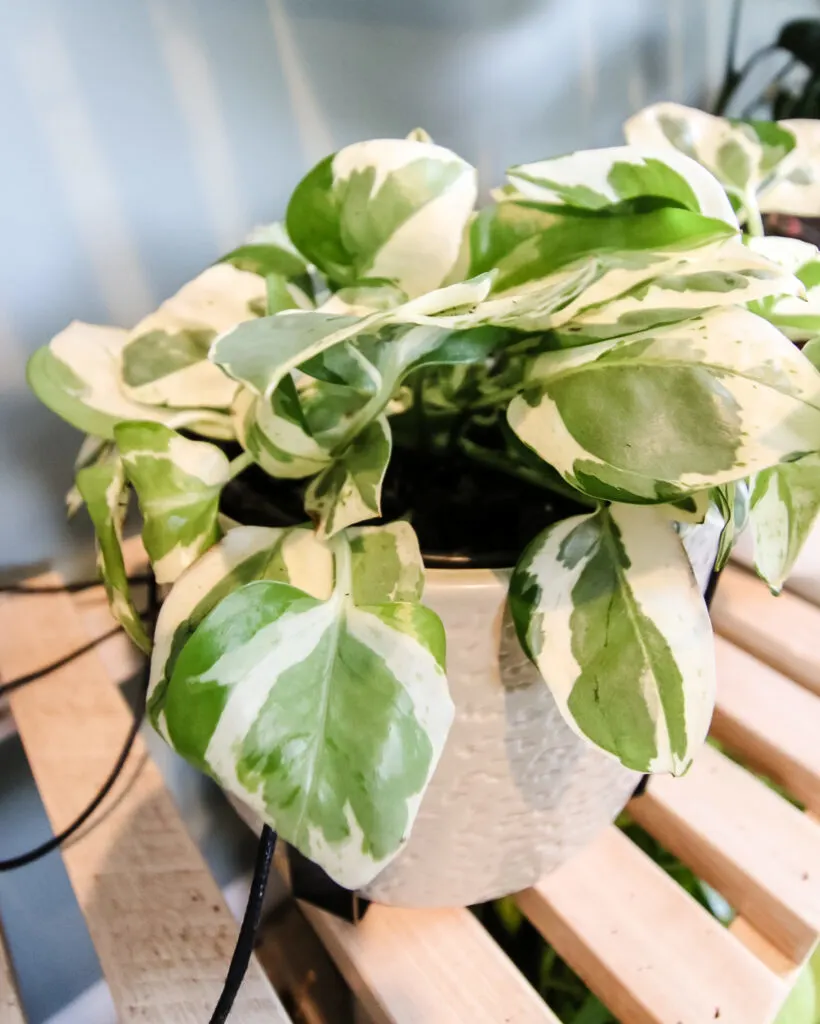
Cissus rhombifolia (Grape Ivy)
Climbing Varieties: Cissus rhombifolia ‘Ellen Danica,’ Cissus rhombifolia ‘Mandaiana’
Cissus rhombifolia, commonly known as Grape Ivy, is a charming houseplant recognized for its glossy, vine-like foliage that resembles grape leaves.
With its trailing and climbing growth habit, Grape Ivy adds a touch of natural beauty to any space, and when supported by a moss pole, it can showcase its cascading vines and lush greenery, making it an excellent choice for beginner plant owners seeking a graceful and low-maintenance addition to their indoor jungle.
Philodendron micans
Climbing Varieties: Philodendron micans ‘Velvet Leaf,’ Philodendron micans ‘Brasil’
Philodendron micans is a captivating houseplant featuring heart-shaped leaves in shades of velvety green with hints of bronze, creating a visually stunning display.
Its trailing vines and easy-care nature make Philodendron micans a popular choice for moss pole enthusiasts, as it gracefully climbs and drapes, adding a touch of elegance and lushness to any interior space.
Epipremnum aureum ‘Marble Queen’ (Marble Queen Pothos)
Climbing Varieties: Epipremnum aureum ‘Neon,’ Epipremnum aureum ‘Snow Queen’
Epipremnum aureum ‘Marble Queen‘, also known as Marble Queen Pothos, is a striking houseplant with marbled, heart-shaped leaves featuring splashes of green and creamy white.
Its cascading vines and ability to thrive in various light conditions make Marble Queen Pothos an ideal choice for moss pole enthusiasts, as it adds a touch of elegance and visual interest while showcasing its beautiful variegation.
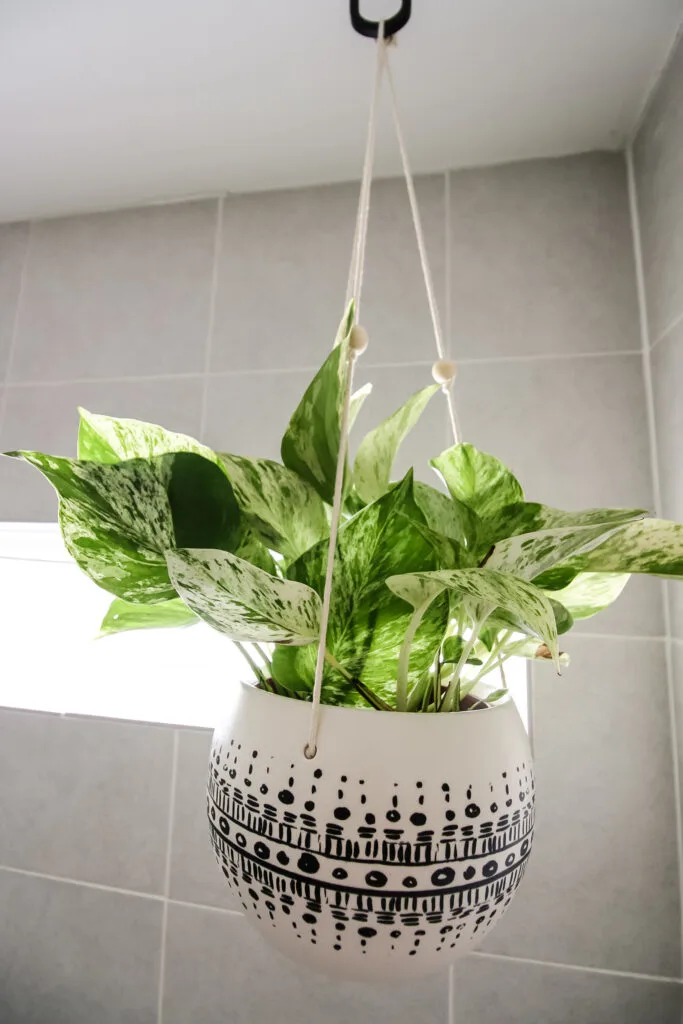
Scindapsus aureus (Golden Pothos)
Climbing Varieties: Scindapsus aureus ‘Marble Queen,’ Scindapsus aureus ‘Pearls and Jade’
Scindapsus aureus, commonly known as Golden Pothos, is a highly popular and easily accessible houseplant, making it an excellent choice for beginner plant enthusiasts.
With its vibrant green leaves and golden variegation, Golden Pothos adds a touch of natural beauty to any space and is particularly favored for its rapid growth, making it a top pick for beginners looking to see their plant thrive and flourish with minimal effort.
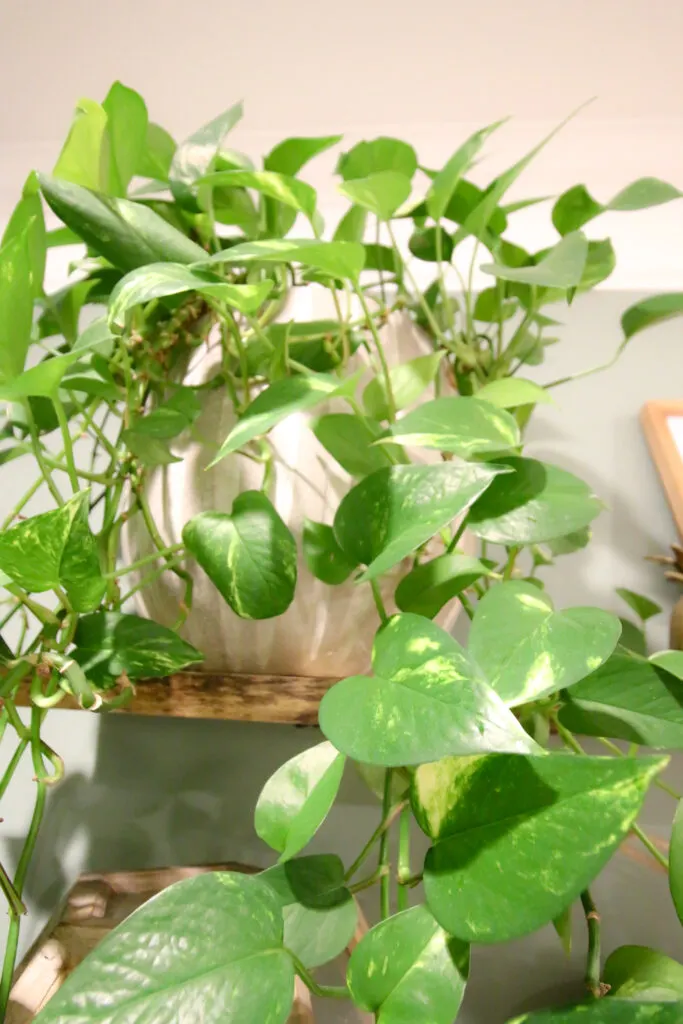
Rhaphidophora tetrasperma (Mini Monstera)
Climbing Varieties: Rhaphidophora tetrasperma ‘Monstera Ginny,’ Rhaphidophora tetrasperma ‘Variegata’
Rhaphidophora tetrasperma, commonly known as Mini Monstera or Monstera Ginny, is a captivating houseplant that shares a resemblance to its larger relative, the Monstera deliciosa, but on a smaller scale.
With its luscious, fenestrated leaves and vigorous growth, Rhaphidophora tetrasperma is not only a stunning addition to any plant collection but also a delight for propagators, as its trailing vines grow long and can be easily propagated to keep or share!
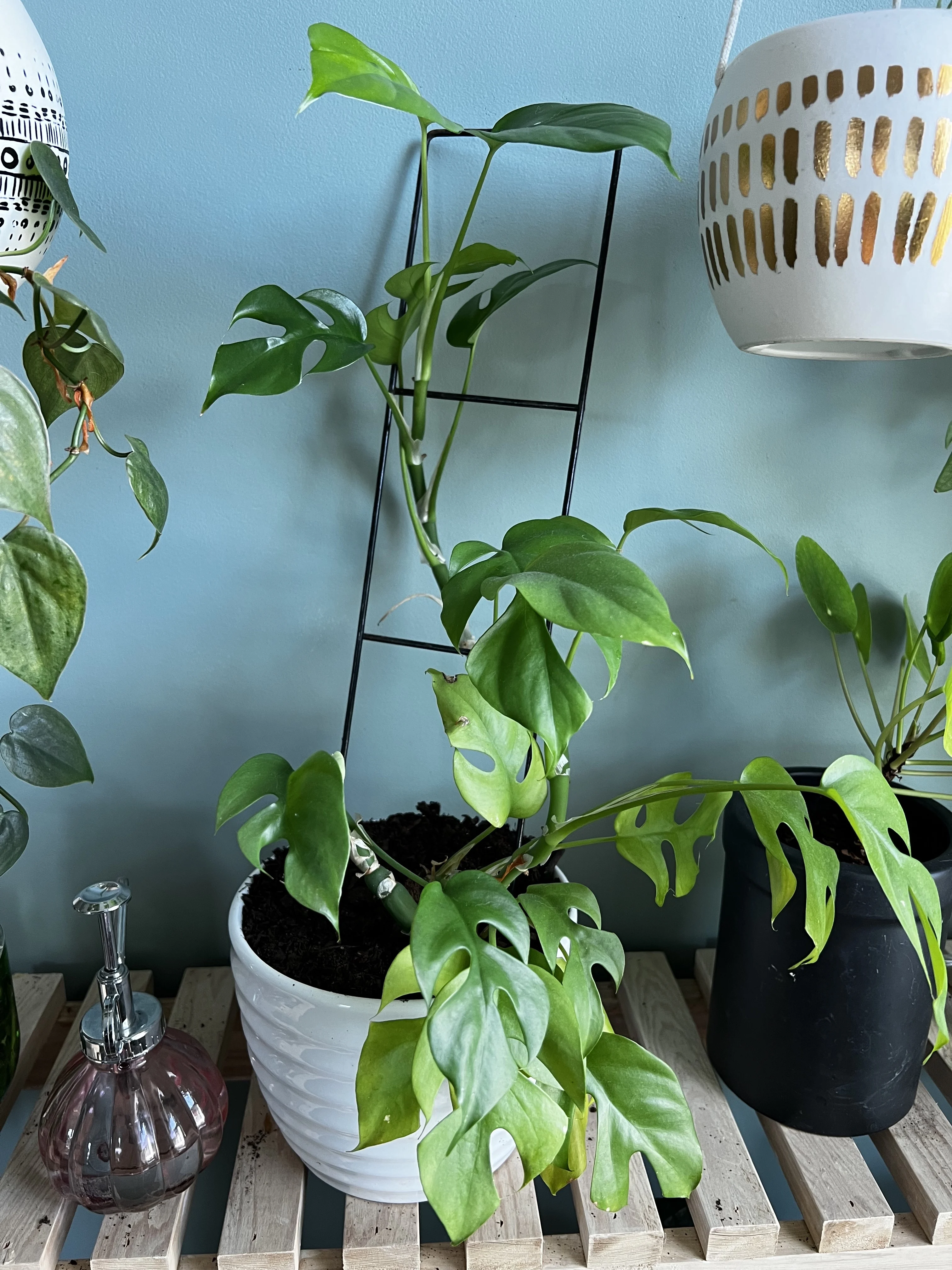
Epipremnum aureum ‘Neon’ (Neon Pothos)
Climbing Varieties: Epipremnum aureum ‘Pearls and Jade,’ Epipremnum aureum ‘Marble Queen’
Epipremnum aureum ‘Neon’, also known as Neon Pothos, brings a vibrant and unexpected burst of bright chartreuse to your plant collection.
With its eye-catching color, Neon Pothos adds a fun and playful element to any space, creating a striking contrast against other green foliage and serving as a lively focal point in your indoor jungle.
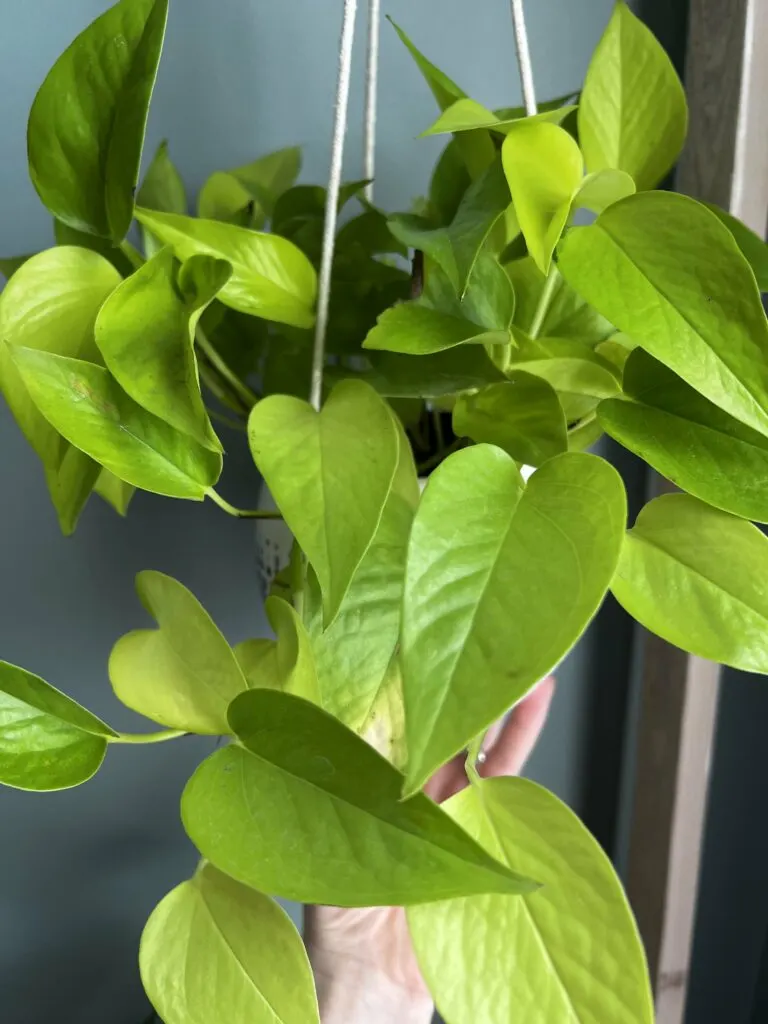
Cissus discolor (Rex Begonia Vine)
Climbing Varieties: Cissus discolor ‘Variegata,’ Cissus discolor ‘Silver Glory’
Cissus discolor, commonly known as Rex Begonia Vine, is a beautiful houseplant appreciated for its unique foliage featuring large, heart-shaped leaves with deep green coloring and silver veins.
Its trailing vines and velvety texture make Rex Begonia Vine an intriguing addition to any plant collection, adding a touch of elegance and a subtle hint of exotic beauty to your indoor space.
Ficus pumila (Creeping Fig)
Climbing Varieties: Ficus pumila ‘Quercifolia,’ Ficus pumila ‘Variegata’
Ficus pumila, commonly known as Creeping Fig, is a versatile and visually appealing houseplant characterized by its small, lush green leaves and fast-growing nature.
With its trailing vines and ability to adhere to surfaces, Creeping Fig adds a touch of natural beauty and a dynamic element to any space, making it an excellent choice for both ground cover and vertical growth, creating a living tapestry of greenery.
Tradescantia zebrina (Wandering Dude)
Climbing Varieties: Tradescantia zebrina ‘Purple,’ Tradescantia zebrina ‘Silver’
Tradescantia zebrina, also known as Wandering Dude or Zebrina Pendula, is a highly popular houseplant admired for its vibrant purple and silver-striped leaves and its rapid growth rate.
This fast-growing and easy-to-propagate plant is a favorite among plant enthusiasts, as it quickly fills up hanging baskets or cascades down shelves, adding a lush and colorful touch to any indoor space while offering ample opportunities for propagation and sharing with fellow plant lovers.
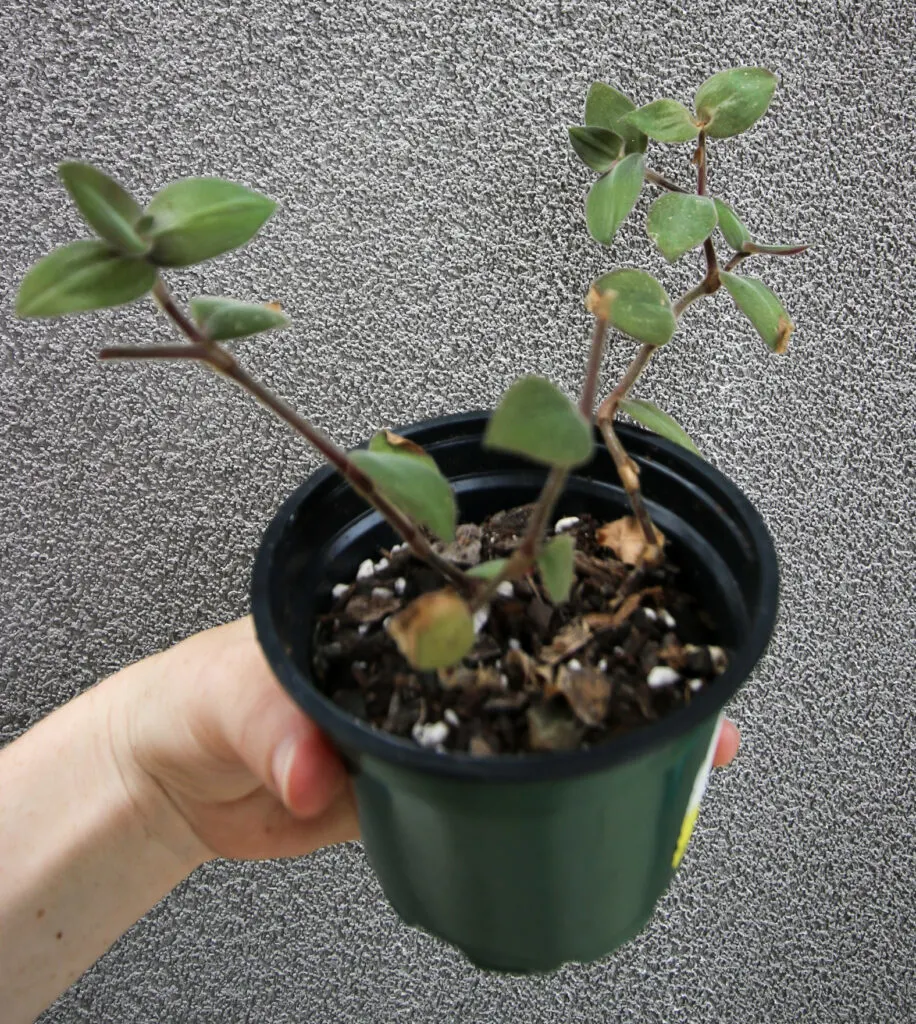
Epipremnum aureum ‘Snow Queen’ (Snow Queen Pothos)
Climbing Varieties: Epipremnum aureum ‘Marble Queen,’ Epipremnum aureum ‘Neon’
Epipremnum aureum ‘Snow Queen’, also known as Snow Queen Pothos, is a stunning houseplant distinguished by its glossy leaves adorned with marbled patterns of deep green and creamy white.
The intricate variegation and trailing growth of Snow Queen Pothos make it a captivating addition to any indoor setting, effortlessly enhancing the aesthetic appeal while providing a low-maintenance option for plant enthusiasts who desire an eye-catching and unique foliage display.
Hoya curtisii (Miniature Wax Plant)
Climbing Varieties: Hoya curtisii ‘Albomarginata,’ Hoya curtisii ‘Variegata’
Hoya curtisii, commonly known as Miniature Wax Plant, is a charming houseplant cherished for its small, succulent-like leaves that showcase beautiful silver flecks and veining.
Its compact growth habit and cascading vines make Hoya curtisii an ideal choice for hanging baskets or trailing down shelves, offering a touch of elegance and a unique texture to any indoor space while requiring minimal care.
Peperomia scandens (Cupid Peperomia)
Climbing Varieties: Peperomia scandens ‘Variegata,’ Peperomia scandens ‘Silver Frost’
Peperomia scandens, also known as Cupid Peperomia, is an adorable houseplant distinguished by its heart-shaped leaves and trailing vines.
Its compact size and easy-care nature make it a perfect choice for small spaces or as a hanging plant, bringing a touch of charm and greenery to any room with its delightful foliage.
Cissus antarctica (Kangaroo Vine)
Climbing Varieties: Cissus antarctica ‘Ellen Danica,’ Cissus antarctica ‘Monkey’s Tail’
Cissus antarctica, commonly known as Kangaroo Vine, is a captivating houseplant characterized by its glossy, deep green leaves and vigorous climbing growth habit.
With its lush foliage and ability to thrive in a variety of conditions, Kangaroo Vine adds a touch of natural beauty and an impressive vertical element to any indoor space, making it an excellent choice for plant enthusiasts looking to create a stunning green display.
Any more questions about moss poles for your houseplants?
Thanks for reading!


Hey there, I’m Morgan, a houseplant enthusiast from sunny Charleston, South Carolina. Growing up surrounded by my mom’s lush orchids and African violets, I discovered the magic of bringing nature indoors. Thanks to the pandemic, I delved deeper into houseplants, discovering their power to uplift moods and transform spaces. I’m here to spill all my secrets, helping you pick the perfect houseplant – and make it happy. Let’s keep your plants alive, together! 😊
